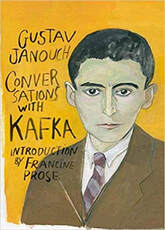Stacy Graber reminds that Kafka just might be perfect for more adolescents than we might think. Stacy is a frequent contributor to Dr. Bickmore's YA Wednesday and her posts always stretch my imagination. Before jumping into Kafka you might check out her posts on Jack Gantos, students and curriculum at the Youngstown English Festival, Updike and others, Kate DiCamillo, Julie Murphy and Joyce Carol Oates, and Semiotics. Just so you know, none of these posts are quite what you think they may be. Stacy will surprise you.
Framing Kafka: YA Texts that Build Background Knowledge Toward Teaching Franz Kafka by Stacy Graber
--Franz Kafka to 17-year-old, Gustav Janouch
Gustav Janouch (1968/2012), Conversations with Kafka
| In this compelling memoir/coming of age account, 17-year old Gustav Janouch lives the fantasy of every Kafka admirer. The young man’s father, who is employed by the Workers’ Accident Insurance Institute for the Kingdom of Bohemia in Prague, introduces his son to a colleague—the lawyer/writer, Franz Kafka. And, from that point forward, adopting a level of intimacy seemingly reserved for Kafka’s confidante, Max Brod, Janouch basically enjoys unmediated access to the writer’s thoughts through a series of dialogues captured on several walks through the streets of Prague. |
David Zane Mairowitz and Robert Crumb (1993), Introducing Kafka
| Another remarkable rendering of Kafka’s life and work is David Zane Mairowitz’ contribution to the graphic Introducing… series, the volume on Kafka. And, no better marriage could there be for a literary tour of the artist’s thematic preoccupations than the angsty, voyeuristic, and satirical art of subversive cartoonist, Robert Crumb. What this book is able to do perhaps better than any scholarly tome is convey the texture of Kafka’s writing through a series of flickering images, a technique descriptive of the visual style of modernist literary experimentation (BBC, 2018). |
Reiner Stach (2016), Is that Kafka? 99 Finds
| Yet another brilliantly accessible introduction to the work of Kafka is the eminent scholar, Reiner Stach’s (2016) texturally Where’s Waldo-like book, Is that Kafka? 99 Finds. In a vibrant Q&A session with translator Kurt Beals, hosted by Deutsch Haus (2017) at New York University, Stach remarks that composition of the book was prompted by German high school teachers’ request for a more accessible context-building resource for teaching Kafka—besides the three-volume biography written by Stach. Seemingly unfazed that his life’s work could not be easily adapted or assimilated, Stach responded to the teachers’ request by writing a book that had the additional benefit of challenging enduring folk-beliefs about the predominately gloomy personality of the writer. |
Digital Sources
Some of the best resources include the following selections:
Alain de Botton’s (2016) School of Life episode dedicated to Kafka negotiates the meaning of the term Kafkaesque through explanation of imbricated social, historical/biographical, political, and cultural tensions. Additionally, the style of the video includes the series-characteristic cut-out dramatization and the art of Egon Schiele.
Will Self’s (2015) video-travelogue, “Will Self’s Kafka Journey: A Prague Walking Tour,” tracks the cultural critic as he tours biographically significant sites in Prague toward interpreting Kafka’s surreal meditation on the vicissitudes of public service, “A Country Doctor.”
Koji Yamamura’s (2007) animated imagining of Kafka’s story, “A Country Doctor,” is a nightmarish vision, which replicates the tone and kinetics of the story through the techniques of distortion, juxtaposition, and tableau.
David Foster Wallace’s (2011) reading of a piece originally published in Harper’s Magazine in 1998, “Laughing with Kafka,” includes explanation as to how DFW helps college students understand Kafka’s idiosyncratic sense of humor through study of conceptual metaphors reminiscent of Lakoff and Johnson’s (1980), Metaphors We Live By.
References
Brod, M. (1995). Franz Kafka: A biography (G. Humphreys Roberts, Trans.). Boston, MA: Da Capo Press. (Original work published in 1937)
De Botton, A. (2016). School of life: Literature: Franz Kafka. Retrieved from https://www.youtube.com/watch?v=g4LyzhkDNBM
Deutsches Haus. (2017). Is that Kafka? 99 finds: An evening with Reiner Stach and Kurt Beals [Video file]. Retrieved from https://www.youtube.com/watch?v=kCjjwBklJZg
Janouch, G. (2012). Conversations with Kafka (2nd ed.) (G. Rees, Trans.). New York, NY: New Directions. (Original work published in 1968)
Kafka, F. (1975). Diaries: 1910-1923. (J. Kresh, M. Greenberg, & H. Arendt, Trans.). New York, NY: Schocken Books. (Original work published in 1948)
Mairowitz, D.Z., & Crumb, R. (1993). Introducing Kafka. New York, NY: Totem Books.
Self, W. (2015). Will Self’s Kafka journey: A Prague walking Tour [Video file]. Retrieved from https://www.youtube.com/watch?v=niIf080qSfE
Stach, R. (2016). Is that Kafka? 99 finds (K. Beals, Trans.). New York, NY: New Directions.
Wallace, D.F. (2011). David Foster Wallace: Remarks on Kafka [Audio file]. Retrieved from https://www.youtube.com/watch?v=SzEO0qFFzwI
Yamamura, K. (2007). Kafka’s, A country doctor. [Animated short film/Video file]. Retrieved from https://www.youtube.com/watch?v=ZDjmW-gIsKs&t=2s




 RSS Feed
RSS Feed